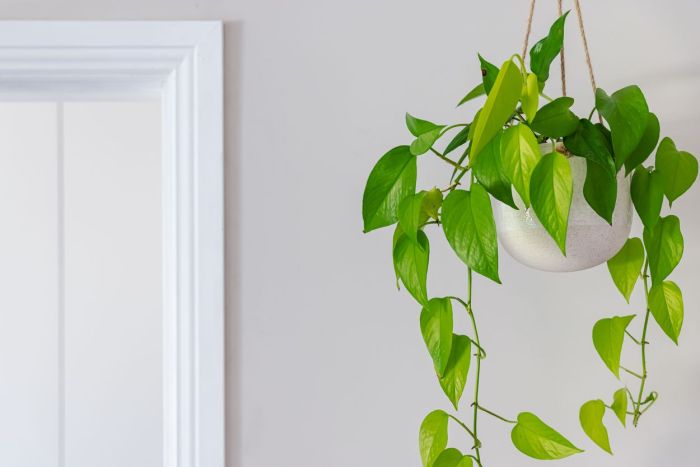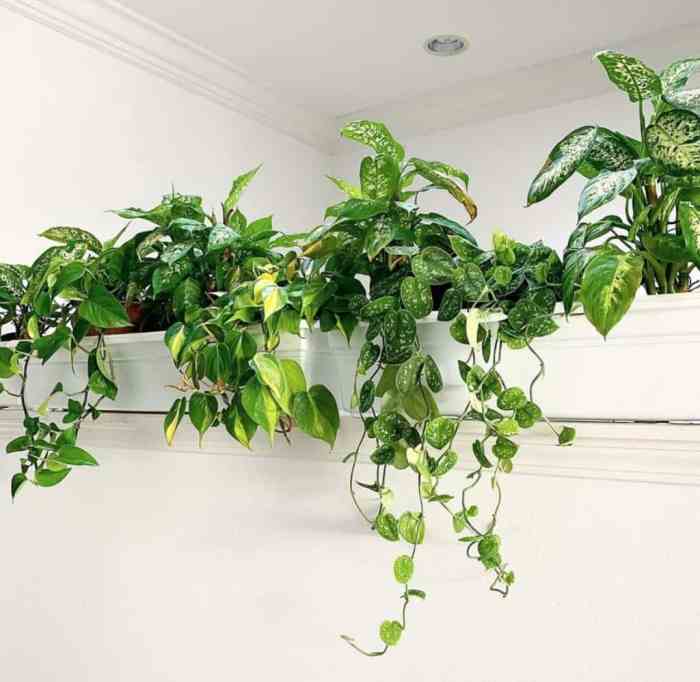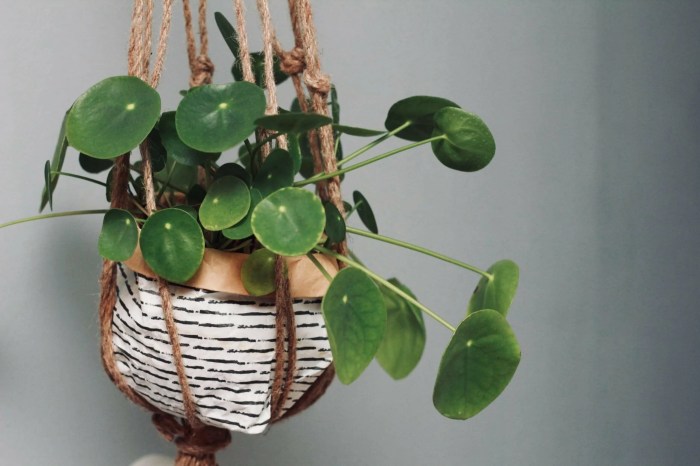Discover the enchanting world of best hanging house plants, where verdant vines cascade gracefully, adding a touch of nature’s beauty to your living space. From air-purifying wonders to stress-reducing companions, these plants not only elevate your décor but also enhance your well-being.
As you delve into this guide, you’ll uncover a treasure trove of information on the different types of hanging plants, their unique characteristics, and the secrets to their proper care and maintenance. Get ready to transform your home into a lush oasis with these captivating botanical wonders.
Types of Hanging House Plants

Hanging house plants add a touch of elegance and greenery to any home. They are perfect for small spaces, as they can be hung from the ceiling or a shelf, freeing up valuable floor space. There are many different types of hanging house plants to choose from, each with its own unique look and care requirements.
Some of the most popular types of hanging house plants include:
- Spider plants( Chlorophytum comosum) are known for their long, trailing stems that produce baby plants, or “spiderettes”. They are easy to care for and can tolerate a wide range of light conditions.
- Pothos( Epipremnum aureum) is another popular hanging house plant. It has heart-shaped leaves that come in a variety of colors, including green, white, and yellow. Pothos is also easy to care for and can tolerate low light conditions.
- String of pearls( Senecio rowleyanus) is a unique hanging house plant that has long, trailing stems covered in small, pearl-shaped leaves. It prefers bright, indirect light and well-draining soil.
- Air plants( Tillandsiaspp.) are a type of epiphyte, which means they grow on other plants or objects. They do not need soil to grow and can absorb moisture and nutrients from the air. Air plants are a great choice for terrariums or other enclosed spaces.
| Plant Name | Type | Description |
|---|---|---|
| Spider plant | Trailing | Long, trailing stems with baby plants |
| Pothos | Trailing | Heart-shaped leaves in a variety of colors |
| String of pearls | Trailing | Long, trailing stems with small, pearl-shaped leaves |
| Air plant | Epiphyte | Does not need soil to grow, absorbs moisture and nutrients from the air |
Benefits of Hanging House Plants

Hanging house plants offer a myriad of advantages, transforming living spaces into havens of well-being. Their presence in homes has been scientifically proven to enhance air quality, reduce stress levels, and elevate aesthetics, fostering a sense of tranquility and improved overall health.
Best hanging house plants can spruce up any room, and offices are no exception. For those seeking to bring a touch of nature to their workspace, consider incorporating hanging plants for office . Not only do they add aesthetic appeal, but certain species can also improve air quality and boost employee well-being.
Whether you opt for cascading ferns, trailing succulents, or blooming orchids, hanging plants are a versatile way to enhance the ambiance of any office while enjoying the benefits of nature indoors.
Air Quality Improvement, Best hanging house plants
Hanging plants act as natural air purifiers, absorbing harmful toxins such as benzene, formaldehyde, and trichloroethylene from the air. By eliminating these pollutants, they contribute to a healthier indoor environment, reducing the risk of respiratory ailments and promoting overall well-being.
Stress Reduction
The presence of greenery in the home has been shown to have a calming effect on the mind. Studies have found that interacting with plants can reduce stress levels, anxiety, and even depression. The act of caring for plants provides a sense of purpose and accomplishment, further contributing to mental well-being.
When selecting the best hanging house plants, consider not only the plant’s beauty but also the type of hanging house plant pots that will complement its growth and aesthetic appeal. From macrame hangers to ceramic pots, there are various hanging house plant pots available to enhance the beauty of your indoor greenery.
These pots not only provide support but also add a touch of style to any room, making your hanging plants a focal point of your home decor.
Aesthetic Enhancement
Hanging plants add a touch of natural beauty to any room. Their lush foliage and vibrant colors create a sense of tranquility and harmony. They can be used to complement existing décor or serve as focal points, bringing a touch of the outdoors into the comfort of your home.
Care and Maintenance of Hanging House Plants
Hanging house plants add a touch of elegance and greenery to any home. However, they require specific care and maintenance to thrive. Understanding their unique needs is crucial for their health and longevity.
Proper watering is essential for hanging plants. They should be watered thoroughly, allowing excess water to drain from the pot. The frequency of watering depends on the plant species, but most require watering once or twice a week. Avoid overwatering, as this can lead to root rot.
Fertilizing is another important aspect of care. A balanced liquid fertilizer should be applied every few weeks during the growing season. This provides the plants with essential nutrients for healthy growth.
Best hanging house plants, like pothos, philodendrons, and ferns, add a touch of greenery and life to any indoor space. For those seeking a low-maintenance option, hanging plants indoor artificial offer a realistic alternative, mimicking the beauty of natural plants without the need for watering or sunlight.
However, if you desire the benefits of purifying air and adding a natural touch to your home, consider investing in living hanging plants that bring both aesthetic and health benefits.
Pruning is also necessary to maintain the shape and size of hanging plants. Remove any dead or damaged leaves and stems regularly. For trailing plants, trim the vines to encourage bushier growth.
Watering, Fertilizing, and Pruning Schedule
| Care Task | Frequency | Specific Instructions |
|---|---|---|
| Watering | Once or twice a week | Water thoroughly, allowing excess to drain. Avoid overwatering. |
| Fertilizing | Every few weeks during growing season | Apply a balanced liquid fertilizer according to package instructions. |
| Pruning | Regularly | Remove dead or damaged leaves and stems. Trim vines for trailing plants. |
Design Ideas for Hanging House Plants: Best Hanging House Plants

Incorporating hanging house plants into home décor can elevate the ambiance and bring a touch of nature indoors. They offer a creative way to add vertical interest, create focal points, and complement various design styles.
By suspending plants from the ceiling or walls, homeowners can maximize space utilization, especially in smaller apartments or rooms with limited floor space. Moreover, hanging plants can draw attention to specific areas of the room, such as a cozy reading nook or a statement wall.
Creating Focal Points
Hanging plants can serve as stunning focal points in a room. Suspending a large, trailing plant, such as a pothos or spider plant, from the ceiling can create a dramatic effect. Alternatively, grouping smaller hanging plants together in a cluster can add visual interest and draw the eye.
Consider placing a hanging plant above a piece of furniture, such as a sofa or armchair, to create a cozy and inviting atmosphere. Alternatively, suspending a plant near a window can allow natural light to filter through its leaves, casting intricate shadows and creating a serene ambiance.
Adding Vertical Interest
Hanging plants can add vertical interest to a room, especially in spaces with high ceilings. By utilizing the vertical space, homeowners can create a more dynamic and visually appealing environment.
Consider suspending a series of hanging plants at different heights to create a cascading effect. Alternatively, installing shelves or plant hangers on walls can provide a structured way to display hanging plants and add visual interest to otherwise bare walls.
Complementing Design Styles
Hanging plants can complement a wide range of design styles, from bohemian to modern. In bohemian-inspired spaces, macrame plant hangers and trailing plants, such as ferns or ivy, add a touch of eclectic charm.
For modern interiors, geometric plant hangers and succulents can create a sleek and sophisticated look. In rustic settings, hanging plants in woven baskets or wooden planters can complement the natural materials and earthy tones.
Troubleshooting Common Issues with Hanging House Plants
Hanging house plants bring beauty and tranquility to any space, but they also come with their own set of challenges. Here are some common problems that can arise and how to address them:
Yellowing Leaves
- Cause:Overwatering or underwatering, nutrient deficiency, lack of sunlight, or pests.
- Solution:Check the soil moisture and adjust watering accordingly. Fertilize regularly and provide adequate sunlight. Inspect for pests and treat if necessary.
Wilting
- Cause:Underwatering, extreme temperatures, or root rot.
- Solution:Water thoroughly and regularly. Move the plant to a cooler or warmer location as needed. Check for root rot and repot if necessary.
Pests
- Cause:Aphids, mealybugs, spider mites, or other pests.
- Solution:Identify the pest and use appropriate treatment methods, such as insecticidal soap, neem oil, or horticultural oil.
Closing Summary
In conclusion, best hanging house plants are not just decorative accents; they are living, breathing companions that bring a myriad of benefits to your home. By incorporating these verdant wonders into your living space, you can purify the air you breathe, reduce stress levels, and create a serene and inviting atmosphere.
Embrace the beauty of nature and elevate your home décor with these exceptional plants.
Question Bank
What are the most popular types of hanging house plants?
Some of the most popular hanging house plants include pothos, spider plants, philodendrons, ferns, and succulents.
How often should I water my hanging house plants?
The frequency of watering will vary depending on the type of plant, but a good rule of thumb is to water when the soil feels dry to the touch.
What are the benefits of having hanging house plants?
Hanging house plants can improve air quality, reduce stress, enhance aesthetics, and add a touch of nature to your home.